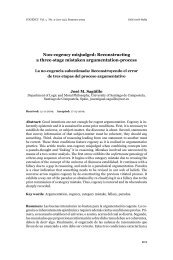Cogency v2 n2
Cogency v2 n2
Cogency v2 n2
Create successful ePaper yourself
Turn your PDF publications into a flip-book with our unique Google optimized e-Paper software.
COGENCY Vol. 2, N0. 2, Spring 2010<br />
ing, argumentation, and concluding phases of a critical discussion. (3) This<br />
theory defines the strategic elements of the maneuvering within the discourse<br />
as results achieved, routes taken, constraints imposed, and commitments<br />
made through definitions. (4) Expansions to this theory explain fallacies,<br />
such as false appeals to authority, as derailments of strategic maneuvering.<br />
(5) The aforementioned features of argument occur as part of the<br />
activity types of adjudication, mediation, negotiation, and public debate.<br />
The chapter emphasizes that understanding the context is key to the reconstruction<br />
and explication of the strategic design of argumentative discourse.<br />
Clearly this chapter’s replication of previous theorizing on strategic maneuvering<br />
will assist readers in understanding how the fifteen essays of the collection<br />
relate to and elaborate existing theory.<br />
In chapter 3, Christopher Tindale makes a useful critique and elaboration.<br />
He claims that rhetoric deserves a prominent place in strategic maneuvering<br />
because the audience participates in argument and reasonableness<br />
is a co-construction of the arguer, audience, and argument. He emphasizes<br />
the prominent role audiences play in the arguers’ design of their arguments<br />
as well as in the effects they produce. Tindale distinguishes his rhetorical<br />
focus from van Eemeren and Houtlosser, claiming that rhetoric gives<br />
issues interest and prominence and it also calls attention to how audiences’<br />
experiences are relevant to arguers’ intent and message design. Audiences<br />
do not just respond to arguments strategically designed by the arguers, but<br />
they aid the construction of arguments through their active participation<br />
with the arguer and their implied presence in the content. By referencing<br />
Chaim Perelman and Lucie Olbrechts-Tyteca, Tindale notes the importance<br />
of the audience to the arguer for identifying the topical potential and for<br />
using presentational devices. Moreover, argumentation does not depend only<br />
on dialectic for its rational component. Rather rhetoric creates intersubjective<br />
reasonableness between arguer and audience without requiring compliance<br />
with a set of dialectical rules. Effectiveness, he says, is measured by<br />
the adherence of audiences to claims, which allows the audience to “bridge<br />
the divide between what is the case for me and what ought to be the case for<br />
others.” Tindale’s emphasis on the audience and rhetorical features as significant<br />
forces in creating reasonableness adds depth to strategic maneuvering<br />
theory.<br />
By stressing the importance of institutional logic to argumentation pro-<br />
150








